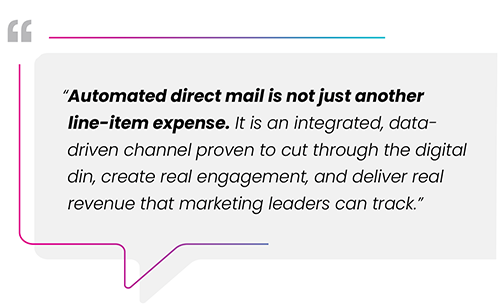The Case for Automated Direct Mail

When the executive team asks for proof, the data is on the side of direct mail.

Introduction
It’s no secret that marketing leaders will be facing new headwinds in 2026. Digital channels are crowded to the point of exhaustion, with prospects swamped by hundreds of emails per day resulting in ever-declining click-through rates. Increasingly, organizations report “inbox fatigue” among buyers, sagging campaign results, and shrinking windows of audience attention. Compounding that challenge, executive leadership and finance teams are more cautious than ever about budgets—in many cases requiring that every investment directly aligns with measurable business impact. Such a climate leaves marketing, demand generation, and operations teams
always searching for bold, yet demonstrably effective, marketing approaches that justify their spend and drive revenue. It must be understood, then, that automated direct mail is not just another line-item expense. It is an integrated, data-driven channel proven to cut through the digital din, create real engagement, and deliver real revenue that marketing leaders can track. What we offer in this guide are practical strategies to help win leadership buy-in for direct mail automation, along with supporting statistics and step by-step approaches—all allowing marketers to make the direct mail business case with confidence and rigor.


Why Direct Mail Deserves a Spot in the Budget
The argument for direct mail in a multichannel world is clear: physical mail’s tangible nature captures attention where digital channels are tuned out.
While email open rates hover around 20 to 30 percent, direct mail routinely achieves open rates as high as 80 to 90 percent across industries. (See “Editor’s Note” below for sources for stats in this article.)What’s more, 90 percent of physical mail is opened by recipients versus just a fraction of that for emails or digital ads. More important, direct mail generates action: in 2024, the average response rate for direct mail campaigns reached between 4.9 percent for prospects and up to nine percent for house (i.e., existing customer) lists, making it five to nine times more effective than email, paid search, or social media.
Organizations, more and more, are recognizing these advantages. Eighty-four percent of marketers surveyed report that direct mail delivers the best response rate of all the channels they use, outpacing digital’s performance significantly. But this isn’t some kind of “nostalgia for paper”—it’s about leveraging the unique combination of sensory engagement, physical presence, and perceived value that only direct mail provides.
84%
“Eighty-four percent of marketers surveyed report that direct mail delivers the best response rate of all the channels they use, outpacing digital’s performance significantly.”

Creating Emotional, Memorable Connections
Data proves what every marketer suspects: physical mail matters more because it feels more personal. The PFL Essential Guide to The Value of Human Connection emphasizes that people crave “moments of connection”—real, sensory experiences that forge meaning and trust. In a world overrun by ephemeral digital touchpoints, a personalized piece of direct mail still has staying power. Whether it’s a handwritten note, a 3Dmailer, or a thoughtfully designed package, the physical nature of mail creates a deeper brand impression that is remembered longer.
Modern campaigns illustrate this well. Marketers are regularly using direct mail to cement relationships at key touchpoints: sending onboarding packages to new customers; surprise gifts for renewals; or milestone celebrations during the contract lifecycle. These thoughtful offline moments prompt action and advocacy that digital campaigns rarely achieve.
Connecting Direct Mail Automation to Business Goals
C-suite leaders want to know: “Will this channel support revenue, pipeline, or efficiency?” Automated direct mail answers decisively. First, it enables triggered, personalized sends based on buyer intent or behavioral data, expanding mail’s potential across the customer lifecycle. For example, a stalled deal can be reactivated with a targeted gift, or a renewal campaign can be triggered by customer anniversary data—lifting the speed and conversion rate of critical touchpoints.
Direct mail automation isn’t just about individual campaigns, though. It’s about integrating physical mail with digital channels for orchestrated, multi-step customer journeys. Forward-thinking operations map direct mail into touchpoints such as:
- Meeting-maker mailers to increase sales appointments.
- Multi-channel nurture programs combining physical and digital engagement.
- Surprise-and-delight packages for retention.
- Win-back campaigns for lapsed customers.
This strategy drives measurable impact—boosting meeting rates, shortening sales cycles, and improving overall campaign ROI compared with digital, or any channel, alone. PFL’s automation platform supports these workflows at scale, delivering the right mail at the right moment.

Direct Mail Idea Books
PFL has produced a variety of “Idea Books” and other e-books on this topic. Here are links to a sampling of the more popular:
The Power of Direct Mail
The Idea Book: Create Authentic MomentsB2C Direct Mail Idea Book
Direct Mail Marketing: An Idea Book for Nonprofit Organizations
Direct Mail Marketing: An Idea Book for Financial Services
Direct Mail Marketing: An Idea Book for Healthcare Providers
Direct Mail Marketing: An Idea Book for E-Commerce & Retail Brands

ROI Proof Points Leadership Cares About
When the executive team asks for proof, data is on the side of direct mail. Traditional direct mail delivers among the highest ROIs in marketing—recent studies show up to 112 percent ROI at the campaign level, with campaigns reporting as much as $42 in revenue for every $1 spent. But, beyond the impressive topline returns are these numbers:
- Response rates for personalized mailings routinely exceed 4 percent, and up to 9 percent for existing customers.
- Ninety-seven percent of organizations see higher response rates with personalized/custom content in direct mail.
- Multi-channel campaigns that integrate direct mail are 27 percent more likely to deliver ROI above benchmark averages.
Automation elevates these results by making every touchpoint trackable. Using CRM integrations, unique URLs, QR codes, and UTMs, marketers can now measure open and engagement rates, track offline-to-online conversions, and reliably attribute closed-loop revenue to direct mail initiatives.
97%
of organizations see higher response rates with personalized/custom content in direct mail

Metrics That Matter to Executives
Smart marketers focus executive conversations on:
- Pipeline contribution (leads/opportunities generated by mail).
- Customer acquisition cost (CAC) efficiency.
- Retention uplift from loyalty-focused mailers.
- Direct revenue attribution (using CRM and marketing automation integration).
Cost vs. Value: How Automation Simplifies Complexity
Historically, direct mail was seen as complex: multiple vendors, long set-up times, risk of manual errors, and an inflexible and unreliable “batch-and-blast” mindset. Automation flips this narrative completely. Modern direct mail platforms centralize vendor management, automate proofing and fulfillment, and integrate with CRM or marketing automation tools—reducing resource drain and administrative costs.
The result: fewer vendors to manage, less manual lift, and more predictable, scalable spend. Automated sending by trigger or segment means organizations can target only high-intent leads or key accounts, maximizing budget efficiency and reducing waste. This is not just a channel expense—it’s an operational win:
- Automated, data-driven sends mean fewer costly broad, untargeted campaigns.
- Less manual labor and lower error rates free teams for higher value work.
- Integration eliminates reporting gaps and shortens time-to-launch.
For CFOs and operations executives, the pitch should be clear: Direct mail automation translates much of the marketing budget into measurable, scalable value—without linear cost increases as programs scale up.

A Step-by-Step Approach to Gaining Business Approval
The best business cases begin by linking direct mail automation to company priorities:
- Identify Alignment: Show how automated direct mail maps directly to pipeline influence, revenue acceleration, or retention goals already on the leadership agenda.
- Pilot Programs: Run a tightly scoped test (e.g., targeted direct mail to a high-value channel for the right moment and the right message.
- Highlight Predictability: Automated platforms bring predictable service level agreements (SLAs), accurate budgeting, and reliable measurement—all addressing leadership’s appetite for risk management.
- Segment and track lift in response or conversions: Use data to prove incremental value.
- Gather Proof Points: Collect ROI benchmarks (see earlier stats),relevant case studies, or competitive examples demonstrating success in similar industries.
- Use Tools and Calculators: Leverage tools such as PFL’s Revenue Calculator to model incremental pipeline or retention impact for your organization.
- Frame for Executives: Keep early conversations focused on revenue impact, CAC efficiency, and scalability—remember, leadership cares about outcomes, not tactics.
- Plan for Scalability: Demonstrate how automation allows small, successful pilots to scale up across teams or regions without linear cost growth.
End every pitch with a rallying cry: Simplify. Personalize. Engage. This summarizes the advantages of automation-powered direct mail—delivering better results with smarter resource use.
Speak the Language of the C-Suite
To move automated direct mail from “nice-to-have” spending to a core growth strategy, marketers must shape conversation in the language of finance and risk management:
- Lead With Revenue, Not Features: Show forecasts for pipeline influenced, deals accelerated, or customer lifetime value increased.
- Show Proof of Measurability: Prove that automation eliminates the “black box” of traditional direct mail. Briefly walk through CRM, UTM, and reporting integrations that make attribution and ROI undeniable.
- Benchmark Costs vs. Digital Engagement: Compare cost per engagement (CPE) for direct mail against email, paid search, or social. Often, the higher engagement and conversion rates seen in mail campaigns mean lower aggregate CPE, especially when automated and personalized.
- Position As Part of Omnichannel: Make it clear that automated direct mail isn’t a wedge issue (“us vs. digital”); it’s a force multiplier in omnichannel campaigns that use the right.
- The kicker for executives: Automated direct mail is how marketing becomes a true driver of measurable revenue, not just a cost center.
For CFOs and operations executives, the pitch should be clear: Direct mail automation translates much of the marketing budget into measurable, scalable value—without linear cost increases as programs scale up.

Conclusion: A Foundational Part of Modern Marketing
Automated direct mail stands out as a measurable, efficient, and deeply personal channel with proven ROI.
End every pitch with a rallying cry: Simplify. Personalize. Engage. This summarizes the advantages of automation-powered direct mail—delivering better results with smarter resource use.
Its integration with automation tools and CRM systems enables fully trackable engagement, head-to-head performance with digital channels, and quantifiable business outcomes that matter to leadership. No longer an “extra”—automated direct mail is a foundational part of the modern marketing stack, reshaping how organizations drive pipeline, lift retention, and maximize every dollar.
Ready to show leadership the impact of automated direct mail? Book a meeting with our team and discover how PFL enables marketers to simplify, personalize, and measure true success.
Maximize Your Impact
For maximum effectiveness, consider these key principles as you implement your direct mail strategy:
- Integration is essential. The most successful campaigns don’t exist in isolation but, instead, create seamless connections between your physical mail and digital channels. QR codes, personalized URLs, and clear online calls-to-action can transform a simple mailer into the starting point of a comprehensive donor journey.
- Measurement drives improvement. Track response rates, donation amounts, and engagement metrics for each campaign to understand what resonates most with your audience. Organizations that consistently measure results can refine their approach over time, leading to increasingly effective campaigns.
- Real stories create real impact. Throughout this guide, we’ve emphasized the power of storytelling. The brands that achieve the greatest success with direct mail are those that share authentic stories of transformation and impact, creating emotional connections that inspire action.
- Testing reveals opportunity. Even small changes in messaging, design elements, or timing can significantly affect your results. Consider testing different approaches—perhaps comparing two versions of a mailing or experimenting with various seasonal themes—to discover what works best for your unique audience.
- Budgets need not be barriers. While some formats might require greater investment than others, effective direct mail campaigns can be designed for organizations of all sizes and budgets. Start with simpler formats, such as postcards or letters, then expand your approach as you demonstrate positive returns.

Direct mail remains a powerful marketing tool because it creates a tangible connection. Here’s a look at how to harness its power and integrate it into broader marketing strategies for optimal results.
Download NowReady to show leadership the impact of automated direct mail? Book a meeting with our team and discover how PFL enables marketers to simplify, personalize, and measure true success.
